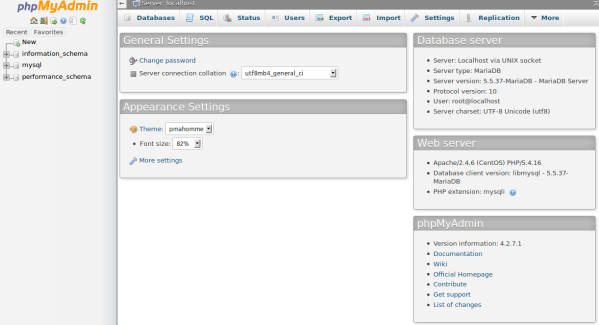
- Install phpmyadmin centos 7 how to#
- Install phpmyadmin centos 7 install#
- Install phpmyadmin centos 7 update#
- Install phpmyadmin centos 7 password#
You can get the download link to the latest version of phpMyAdmin from following URL. For PHP 7, we need to manually download and setup phpMyAdmin web interface. Important: Epel repository provides a phpMyAdmin package for PHP 5, But it is not compatible with PHP 7.
Install phpmyadmin centos 7 install#
Today will install phpMyAdmin to work with PHP 7. creating object classes.In a previous article, we installed lamp stack on CentOS 7. The phpLDAPadmin tool comes in handy for easy LDAP administration, especially for newbie system administrators although some configurations still have to be done on the command line, e. It is a safe practice to have SSL certificate installed on the server running phpLDAPadmin to ensure information is encrypted. You only need to enter the ldapadm password The login DN details should be pre-populated if you correctly configured your phpldapadmin config file. You can go ahead and login by pressing the login button on the sidebar menu. The landing page should look like the one below.
Install phpmyadmin centos 7 how to#
You can learn how to patch the bugs here.Īfter fixing the bugs, you can access your LDAP administration dashboard here: If you are using php version 7.2, phpLDAPadmin has a lot of compatibility issues with it due to using deprecated functions. Line 397 should be uncommented to ensure the login credentials used are the domain name details and not the user identification (so comment out line 398) $servers->setValue('login','attr','dn') So change line 388 appropriately: $servers->setValue('appearance','password_hash','ssha')
Install phpmyadmin centos 7 password#
The password hashing algorithm set should be ssha. Special Note: The LDAP DN are set when installing and configuring LDAP on your CentOS 7. $servers->setValue('login','bind_id','cn=ldapadm,dc=example,dc=hostadvice,dc=local') Line 332 will define your domain details, change it appropriately.

The default port for the LDAP server is left to 389 (non-standard port), you can change it by uncommenting line 301: $servers->setValue('server','port',389) To manage another LDAP server other than the localhost, you can uncomment and change the setting on line 298, entering the appropriate IP address: $servers->setValue('server','host','127.0.0.1') The following changes are to be made in the php code:Ĭreate a name for your LDAP server that will appear for users on the admin dashboard this setting is located on line 291 $servers->setValue('server','name','Hostadvice LDAP Server') Open the configuration file with your favourite editor. Modify your configuration file located at /etc/httpd/conf.d/nf to look like the one below: Alias /phpldapadmin /usr/share/phpldapadmin/htdocsĪlias /ldapadmin /usr/share/phpldapadmin/htdocs $ sudo systemctl start sldap & sudo systemctl enable sldap Install the phpLDAPadmin $ sudo yum -y install phpldapadmin Configure the phpLDAPadmin Virtual Host The ldap services need to be started and also be enabled to start automatically on boot up. $ sudo yum install epel-release Start LDAP services The Extra Packages for Enterprise Linux (EPEL) release updates have to be installed because phpLDAPadmin is not available in the main repository. $ sudo yum install php-ldap php-mbstring php-pear php-xml You need to install php-ldap and a few other php packages needed to run phpLDAPadmin.
Install phpmyadmin centos 7 update#
Steps Update system packages $ sudo yum update & sudo yum upgrade Install extra PHP packages Special Note: If you decide to follow these tutorials, you should already have installed PHP too. You can also learn How to Install the LEMP (Linux, Nginx, MySQL, PHP) Stack on CentOS 7 VPS or Dedicated Server You can learn How To Configure the Lightweight Directory Access Protocol Server on a CentOS 7 VPS or Dedicated Server



 0 kommentar(er)
0 kommentar(er)
